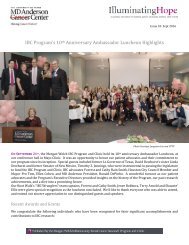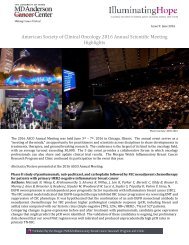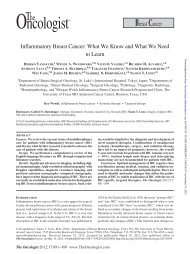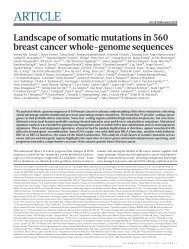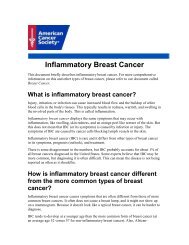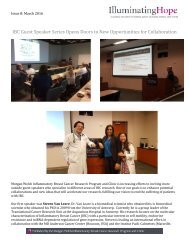Iluminating Hope - The Newsletter of the MD Anderson Morgan Welch IBC Research Program and Clinic - Issue 9 June 2016
You also want an ePaper? Increase the reach of your titles
YUMPU automatically turns print PDFs into web optimized ePapers that Google loves.
<strong>Issue</strong> 9: <strong>June</strong> <strong>2016</strong><br />
cancer tumorigenesis <strong>and</strong> metastasis”.<br />
Dr. Ch<strong>and</strong>ra Bartholomeusz, Assistant Pr<strong>of</strong>essor (Breast Medical Oncology) was awarded <strong>the</strong> Institutional<br />
<strong>Research</strong> Grant for “Overcoming MEK-inhibitor resistance in TNBC by targeting Mcl-1, anti-apoptotic protein.” Her<br />
research using <strong>IBC</strong> cell lines holds promise in identifying <strong>the</strong>rapeutic targets for <strong>IBC</strong>.<br />
Recent Publications<br />
miR-141-Mediated Regulation <strong>of</strong> Brain Metastasis From Breast Cancer<br />
Bisrat G. Debeb, Lara Lacerda, Simone Anfossi, Parmeswaran Diagaradjane, Khoi Chu, Arvind Bambhroliya, Lei Huo,<br />
Caimiao Wei, Richard A. Larson, Adam R. Wolfe, Wei Xu, Daniel L. Smith, Li Li, Cristina Ivan, Pamela K. Allen, Wenhui<br />
Wu, George A. Calin, Savitri Krishnamurthy, Xiang H. Zhang, Thomas A. Buchholz, Naoto T. Ueno, James M. Reuben,<br />
Wendy A. Woodward<br />
About 15% to 30% <strong>of</strong> patients with advanced breast cancer develop brain metastases <strong>of</strong> which triple-negative <strong>and</strong><br />
human epidermal growth factor receptor 2 (HER2)–overexpressing cancers are disproportionately represented.<br />
Despite major advances in treatment <strong>of</strong> primary breast cancer <strong>and</strong> systemic malignancies, <strong>the</strong> prognosis for patients<br />
with brain metastases remains dismal, with median survival times ranging from five weeks without treatment to six<br />
months with multimodality treatment. Also, <strong>the</strong> incidence <strong>of</strong> brain metastases is increasing with <strong>the</strong> advent <strong>of</strong><br />
effective targeted systemic <strong>the</strong>rapies for breast cancer such as trastuzumab. Despite <strong>the</strong> substantial clinical need,<br />
<strong>the</strong> molecular basis for brain metastasis is still poorly understood.<br />
Herein, we developed <strong>and</strong> characterized novel brain metastasis mouse models <strong>and</strong> investigated <strong>the</strong> potential role <strong>of</strong><br />
miR-141 in brain metastatic colonization <strong>of</strong> breast cancer cells. <strong>The</strong> study suggests miR-141 is a regulator <strong>of</strong> brain<br />
metastasis from breast cancer <strong>and</strong> should be examined as a biomarker <strong>and</strong> potential target to prevent <strong>and</strong> treat brain<br />
metastases.<br />
Histone deacetylase inhibitor-induced cancer stem cells exhibit high pentose phosphate pathway<br />
metabolism<br />
Bisrat G. Debeb, Lara Lacerda, Richard Larson, Adam R. Wolfe1,5, Savitri Krishnamurthy, James M. Reuben, Naoto T.<br />
Ueno, Michael Gilcrease, Wendy A. Woodward<br />
Through this study, it was demonstrated that histone deacetylase (HDAC) inhibitors can “reprogram” differentiated<br />
triple-negative breast cancer cells to become quiescent stem-like cancer cells. We hypo<strong>the</strong>sized that <strong>the</strong> metabolic<br />
state <strong>of</strong> such cells differs from that <strong>of</strong> <strong>the</strong>ir differentiated progeny. In untreated cells, glucose uptake was higher in<br />
ALDH + cells than in ALDH – cells (p = 0.01) but lactate production was not different; treating ALDH – or ALDH + cells<br />
with VA or SAHA similarly increased glucose uptake without changing lactate production but upregulated G6PD, a<br />
rate-limiting enzyme in pentose phosphate pathway metabolism. NADPH production was higher in HDAC inhibitortreated<br />
stem-like cells than in vehicle-treated cells (p < 0.05). Two G6PD inhibitors, 6-aminonicotinamide <strong>and</strong><br />
dehydroepi<strong>and</strong>rosterone, decreased mammosphere formation efficiency <strong>and</strong> ALDH activity <strong>and</strong> 6-<br />
aminonicotinamide reduced <strong>the</strong> VA-induced increase in ALDH + cells. Finally, patients expressing high G6PD mRNA<br />
had significantly worse overall survival (p < 0.001), <strong>and</strong> patients with high G6PD protein showed a similar trend<br />
towards worse disease-specific survival (p = 0.06). (G6PD) expression was evaluated in a tissue microarray from 94<br />
patients with node-positive invasive breast carcinoma <strong>and</strong> in two publically available databases <strong>and</strong> correlated with<br />
overall survival. Energy metabolism in HDAC inhibitor-induced stem-like cancer cells differed sharply from that <strong>of</strong><br />
differentiated cell types. HDAC inhibitor-induced dedifferentiation promoted metabolic reprogramming into <strong>the</strong><br />
pentose phosphate pathway, which is targeted effectively by G6PD inhibition. <strong>The</strong>se findings show a potential for a



